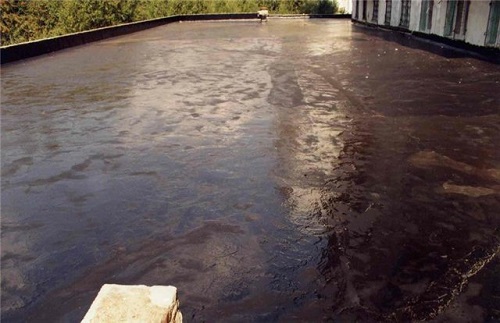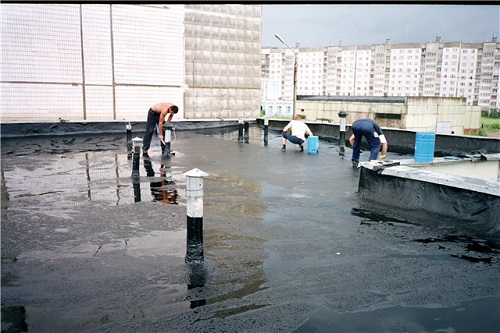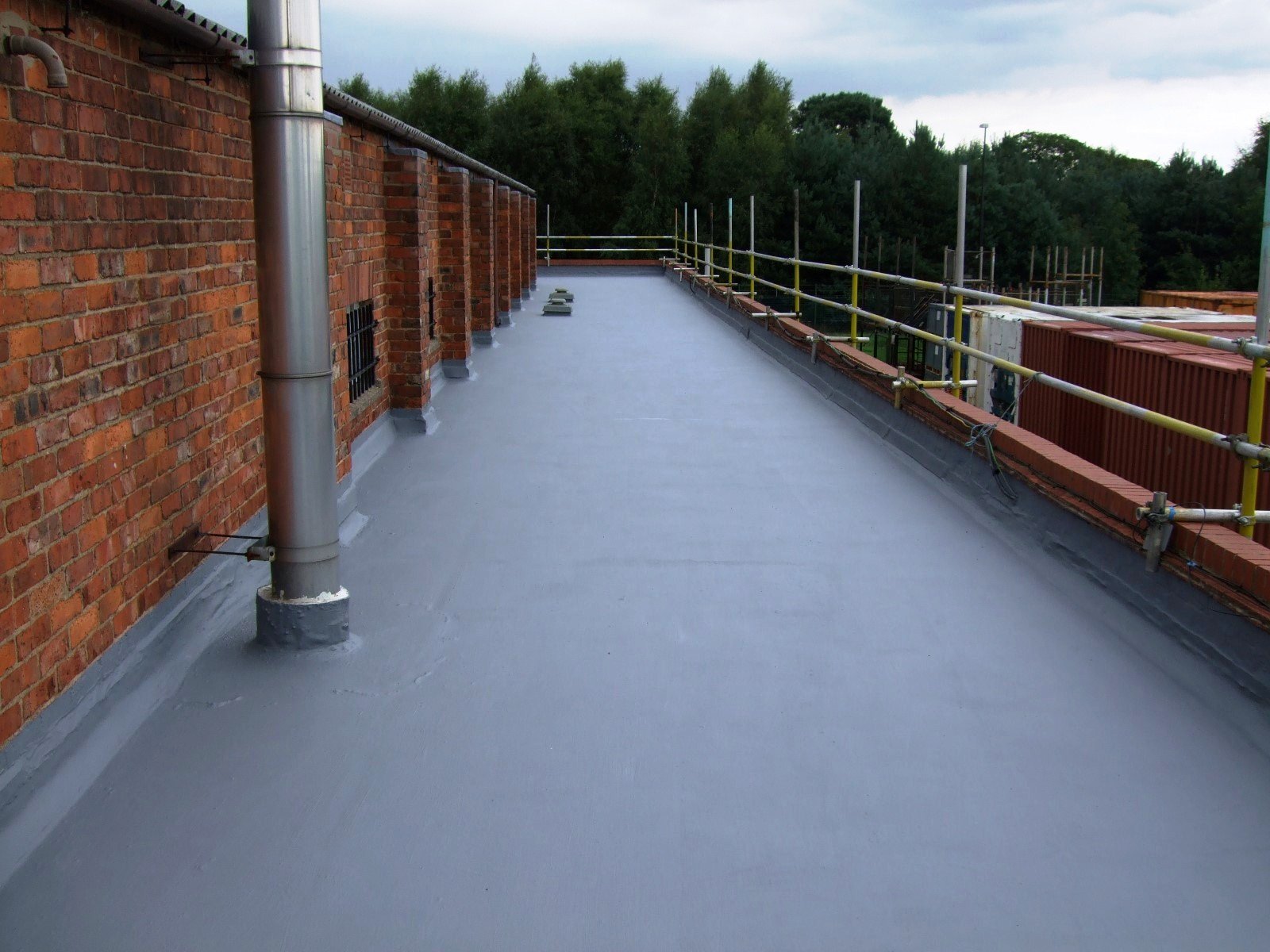Self-leveling roofs are most often used in the construction of industrial or utility buildings, for which the main are the excellent strength and protective properties of the roof, and not the beauty and aesthetics of the form.
The bulk roof has many positive properties, which are much more than negative. The amount of work and time required for its construction will be required much less than for the installation of other roofs, and its waterproofing properties, thanks to the seamless technology, perfectly protect the building from bad weather for many years.
Content
Self-leveling roof, what is it?

Bulk roofing is nothing more than a seamless coating, which consists of two main layers (reinforcing and waterproofing). The reinforcing layer is created on the basis of fiberglass or fiberglass, and the waterproofing layer contains various polymeric or bitumen-polymer materials (mastics). Therefore, the bulk roof is sometimes also called mastic.
The basis for applying the mastic is reinforced concrete (concrete) slabs, as well as screeds made of cement mortar with sand, metal, wood, flat slate and other materials. The outer surface of the roof is painted with a special paint on a solvent, which increases the reflectivity of the roof.
The mastic roof is applied to a solid foundation by pouring a liquid composition (from one or two components). Only after hardening the coating takes the form of a monolithic, rubber-like material that is resistant to aggressive media, vapor permeable, protects against ultraviolet radiation and temperature changes. Such a roof is good for all weather conditions, even for northern regions with a harsh climate.
The poured roof from bitumen mastic, having turned into a flexible material after hardening, has excellent waterproofing characteristics and is not afraid of low temperatures (-50 degrees), as well as high (up to +120 degrees). Such a roof not only protects against rainfall and temperature extremes, but is also considered the most durable and durable.
At the same time, mastic roofs very noticeably reduce construction costs, since many works have a high level of mechanization, which means that much less labor is required for its construction, literally, 5-10 times in comparison with other technologies. Therefore, such roofs are widely used in industrial construction.
The advantages of a bulk roof include the absence of seams, and its disadvantages include difficulties in obtaining the same thickness of the layer covering the entire area of the base. The created waterproofing layer of polymer mastic, if necessary, can be reinforced with a special mesh, which is usually made of fiberglass.

Do not start installation of the bulk roof if the base for the coating has not dried out from the rain, or if regular weather reports predict new precipitation in the coming days.
Types of materials for bulk roofing
Depending on the size of the slope, the mastic roofs are divided into the following groups:
- FROM flat roof. The slope angle should not exceed 2.5 degrees, which can significantly reduce the labor required to create such a roof. This is due to the fact that the molten material almost does not drain in one direction, which means that you can do without reinforcing the bulk layers.
- With a slope of 2.5 to 25 degrees. Such a slope no longer allows you to perform work without the use of reinforcing materials, which are necessary to create obstacles to the runoff of a liquid hot composition until it completely hardens.
- Standard pitched roof (bias of more than 25 degrees). At such a slope angle, it is simply not recommended to carry out installation work of mastic bulk roofs.
All bulk roofs, as a rule, consist of 3-5 layers and are divided by their structural component into reinforced, unreinforced and combined.
Common to all types of mastic roofing technology in technology is the first application of a hot protective layer by spraying onto the prepared base. Only after the formation of an elastic waterproof film, the following layer is applied to it, depending on the type of the bulk roof:
- Reinforced roof. To increase the service life of such a roof, the middle layers of the emulsion of bitumen and polymers are reinforced with materials based on fiberglass (most often fiberglass or fiberglass mesh is used).
- Unreinforced roof. A continuous waterproofing coating is formed by applying to the prepared base an emulsion of the EGIK brand and several subsequent moisture-proof layers of mastic (with a total thickness of about 10 mm), and stone crumb or fine gravel is added to the topmost layer.
- Combined roof. This type of bulk roof is mounted by alternating layers of mastic with rolled material. The lower layers are tried to be made of inexpensive and affordable materials, and the upper ones, as a rule, are additionally covered with mastic, which is reinforced with fine gravel or waterproof paint.
Bulk roof coating device

Let us consider in more detail the device and installation technology of the most common bulk roof.
For the base of the bulk roof, concrete slabs with a fairly flat surface are most often used. Some experts prefer to prime the slabs with cement and sand before applying the mastic.
To improve the bonding of materials, a solution of bitumen in kerosene is applied to the surface of this mounted base. In this case, the primer is prepared from the same bitumen-latex emulsion (but without a coagulator).
As previously reported, a protective layer of hot mastic with a filler of fine gravel or mineral chips is then applied to the cleaned base.
Each subsequent layer is applied only after the final hardening of the previous coating. Layers with an average thickness of 2 mm can be reinforced or not reinforced, depending on the technology you choose.
The main coating material is bituminous hot mastic, bitumen-rubber mastic or bitumen-latex cold emulsion with coagulators. Asbestos may be added to hot bituminous mastics as a filler.
Installation of a bulk roof begins with grooves and from those places where water intake funnels are located.
Laying layers is performed in the following order:
- First, the reinforcing cloths are spread all over the base.
- A layer of hot mastic (bitumen, roofing) is applied on top of these paintings. After the reinforcing layer is very well impregnated, it will firmly adhere to the base.
- To protect the roof, a layer of gravel is poured on top.
The edges of the roof are additionally reinforced with a layer of mastic and reinforcing special material. Then cover the cornice with galvanized steel to organize the flow of water.
All mastic coating works are well mechanized (up to 90%), in contrast, for example, with roofing material coating (30%). The volume of labor during the installation of a bulk roof is much less (2-3 times), and the amount of time before the next repair grows 3 (or more) times.
The consumption of materials during the construction of a new bulk roof is approximately 8 kg of mastic per square meter of roof area, and for the repair of an old roof - about 4 kg per square meter.
Self-leveling roofs are widely used in the construction of not only industrial, but also residential buildings, as well as for insulation of basements and in the repair of roofs with alternative coatings. It has a lot of advantages, which determines its growing popularity at the present time.


Alas, no comments yet. Be the first!